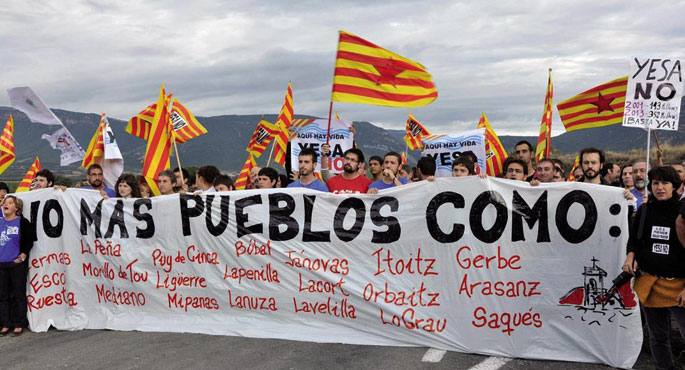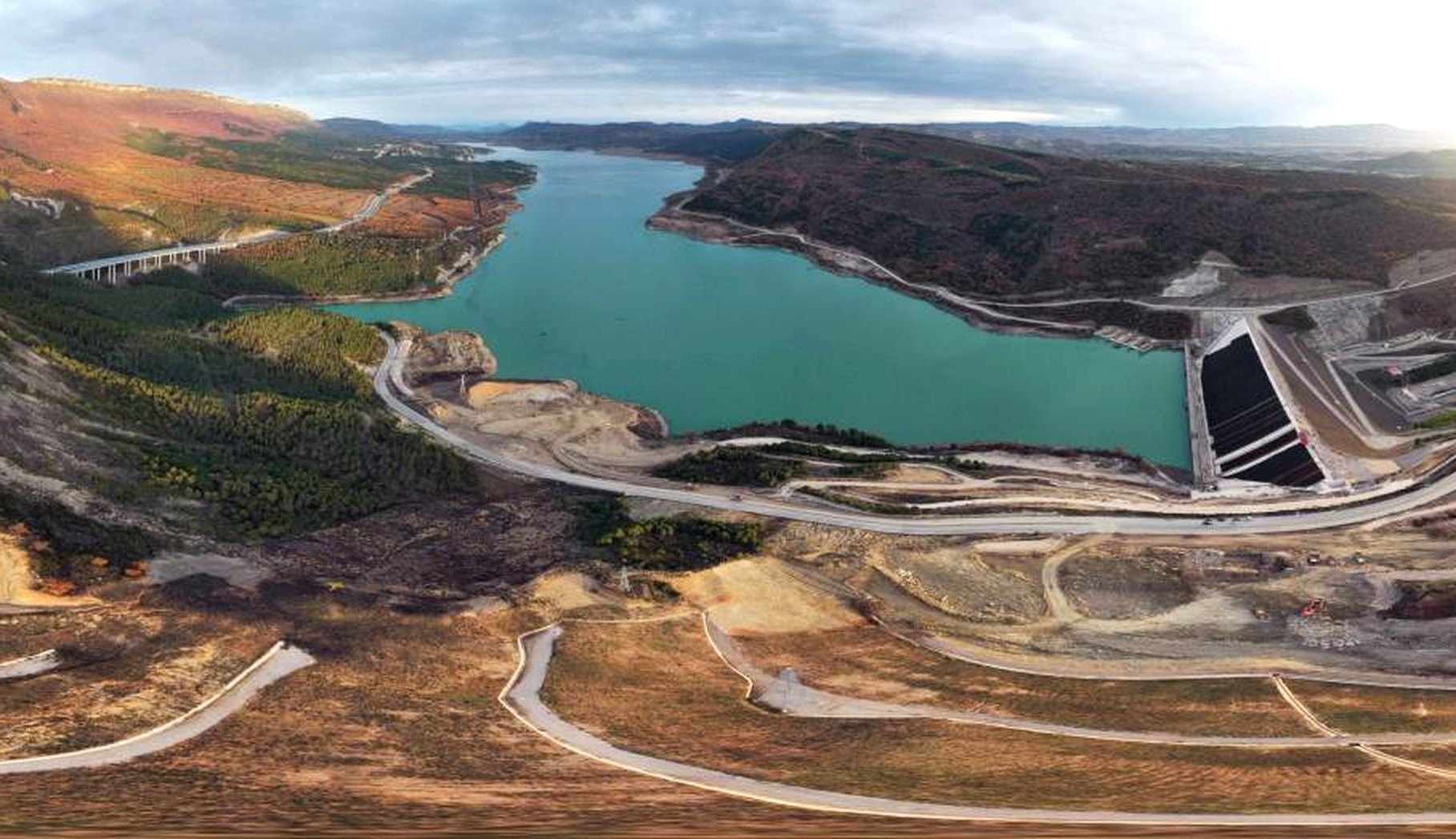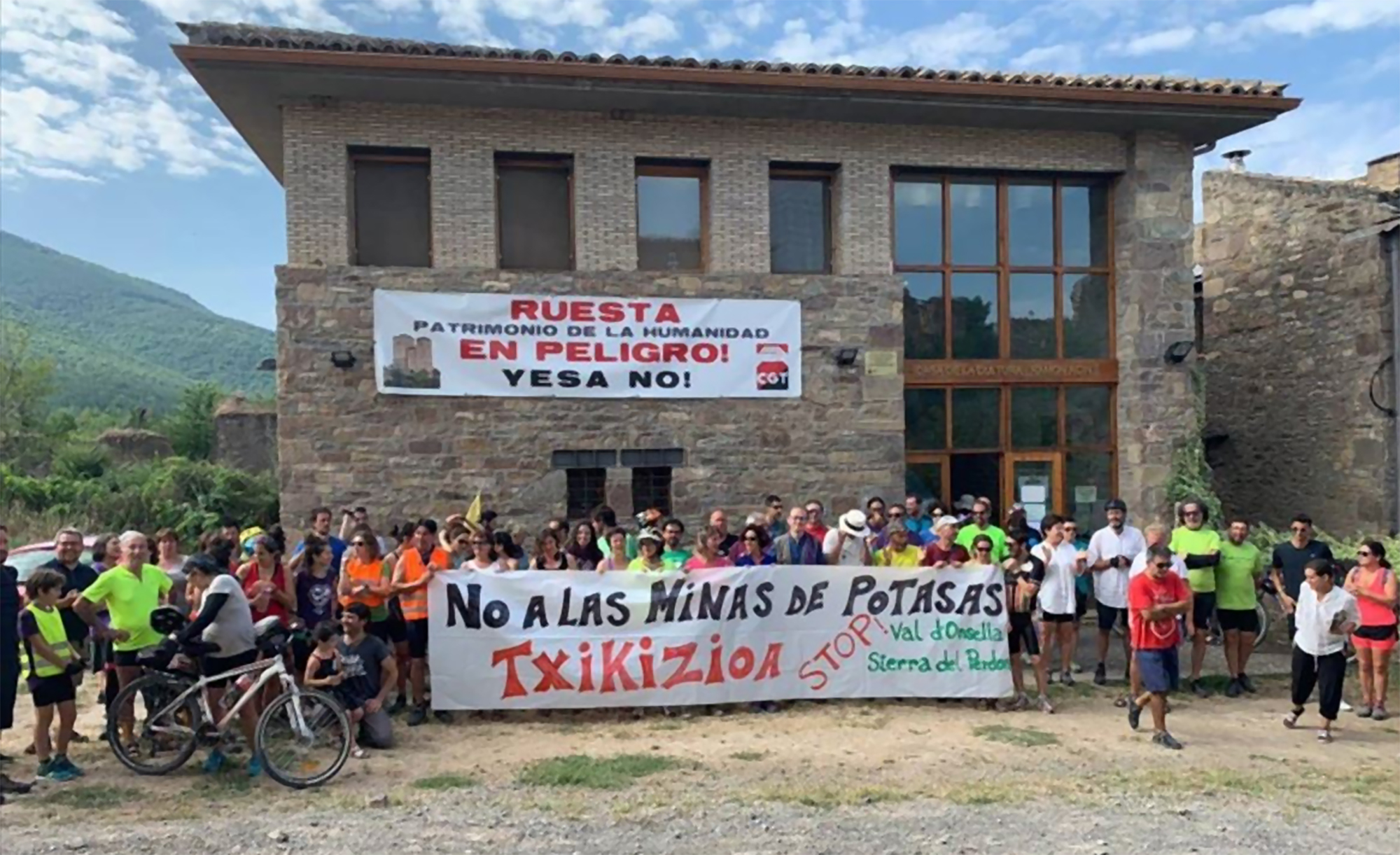A senseless project
- A number of Aragonese towns are threatened by the plan to double the capacity of the La Rioja swamp. We have been in Artieda, which has become the symbol of the fight against the project. Despite set-aside, the long-standing resistance has shown that concrete cannot sink dignity.

“They have a party with us. We're not going to leave here. We are being robbed of the land, but we are not going to leave our homes.” Artieda is located on the eastern end of the reservoir of Yesa, in Aragonese lands, at the gates of the sea of 18 kilometres in which the river Aragon rests. There we met Luis Solana, farmer and farmer. It is the former mayor of the locality and president of the Rio Aragón association, opposed to the proposed expansion of the swamp. When he speaks, the traces left by the struggles of these 30 years are clearly visible. From the upper part of the town we have been told about the Esa reservoir, and to duplicate its capacity, the concrete pillars of the new road for trucks and excavators that is part of the plan, and the lands that they have devoured, and in the village skirts, more cultivation plots that are currently in the focus of the authorities. “For the harvest we have 600 hectares of good quality, and they want to expropriate more than 200. Steal. That is the right word. They don’t care to know that taking a small piece of land from some farmers can also prevent them from moving forward.”
Solana complains of the “arrogance” of the Spanish Ministry of the Environment and of the Ebro Hydrographic Confederation (CHE), of the “pride” of the water vendors. One of the reasons why we want to expand the Yesa is, according to the politicians, that through the Bardenas Canal, which is part of the reservoir, more plots of the Ribera and the Zinco Billas region, in northern Zaragoza, can be irrigated. However, the collective Río Aragón considers that the objective is not to satisfy the demand of the farmers, but to bring the water to the area that most interests them, for economic reasons. The President of the Association tells us that these works have been requested by the Community of Bardenas Regantes: “These organizations make policy, they are an instrument of pressure. Water is for them a source of business, an economic resource. They have a water concession and they feel like they own it. Sometimes you park the cars down here and you're going to see the works to see how your reservoir is, like the little animals you're going to visit the pitches. Next to them are the representatives of the CHE. The water management institution is at the service of these communities. It’s unacceptable.”
The Lie of Irrigation
The project detractors say that it is not necessary to expand Yesa to expand the irrigation areas of the Bardenas. “It’s enough to build half a dozen small rafts to keep the water on the Canal route,” says Solana. “As official data show, it would be possible to meet the requests without increasing the cost.” In his words, the management of these rafts – water – would be in the hands of the water regulators, who have made the request. “Thus, the cost of water conservation would be borne by the operators. Instead of using their resources, they take ours, among them the most fertile lands, causing damage to repair,” explains Solana, who talks about a “colonial policy.” In similar terms, Jorge Bielsa, economist and professor at the University of Zaragoza, spoke at a conference in Jaca last month: “It is important to know in advance the cost of these infrastructures and that the applicants for the works take care of the costs. Unfortunately, they still hope that sooner or later we will all pay.”
Solana explains that another element to consider is the hydroelectric exploitation of the canal: “These communities, in theory, have only one concession for irrigation, but they are building power plants and doing business.”
Although the dam is in Navarra, it says that there is talk of this project in Aragon, which is requested by the Aragonese. “Watering in these areas is like a myth. We have a lot of dry soil, and many people think that only water will make them live. ‘When the water comes, things will fix,’ we’ve heard many times. That has a lot of weight in the subconscious of citizenship, people think that reservoirs are good works, which represent a breakthrough. In addition, where there was nothing before, there is now water and crops. That simplistic view has marked a lot of public opinion and the political parties that engage in voter fishing, including IU, are also playing that game.”
Main concrete lobby
Another argument put forward by the supporters of the extension of the reservoir is this: For the whole city of Zaragoza to have quality drinking water, it is essential that the works be completed as soon as possible. On the contrary, according to the Coordinator of Affected by Reservoirs and Major Transbases (COAGRET), the capital has an infrastructure to store and use the water of the mountains: Loteta dam that joins the Imperial Canal of Aragon. Combined with the cubic hectometers of the Ebro River and the rafts that can be built, it is estimated that Zaragoza would have a water tank of one year.
Solana has pointed out that, although the Spanish Water Law prioritizes water from the mouth – potable –, Zaragoza would have potable water if the water that would be used for irrigation were to be excessive. “The water supply of the capital is secondary,” he says, the concessions for expansion are those of the inauguration of Esa. “It’s easier to drive out of the people than to change concessions,” he says. “But they won’t.”
The water reserve for possible transfers that might quench the speculative thirst of the Mediterranean area is one of the hidden reasons for this project, according to the biologist of the University of Zaragoza, José Manuel Nicolau. “The other thing is to defend the interests of the concrete lobby,” added Solana. “Have you seen the heap of cement around? Both the PSOE in 1992-93, and the PP in 2001 – with the plan of the Ebro base – and the subsequent National Hydrological Plan (2005) have proposed a similar developmentalist model.” This swamp follows this strategy, as well as the Biscarrues dams – which if the project were to succeed would receive the waters of the River Gállego – and Mularroya – which have begun to be built in the Jalón Valley.
For a socialist and revolutionary Aragon
The fight against these major infrastructures is one of the fundamental axes of the leftist and independentist groups in Aragon. Artieda has become a symbol of resistance because of his commitment for years to the Yesa project and to the defense of the land. A reflection of this is the Esfendamos a Tierra Conference that is held there once a year and the act that last weekend conjugated the claim and celebration for the dignity of the mountain. We were in Artieda while they were preparing.
The Independence Block of Cuchas (BIC) has organized these days in recent years, with the collaboration of the City Hall headed by Chunta Aragonesista (CHA). Founded in 2007, the BIC aims to accumulate leftist forces to work together for a “free, anti-patriarchal, socialist and revolutionary Aragon”. It brings together half a dozen groups: Puyalón de Cuchas (political organization), Purna-A Chobenalla Reboluzionaria e Independentista (youth organization), A Clau Roya (feminist group), A Enrestida (anti-fascist group), the SOA-STA trade union and the group of independent and revolutionary students Universidat.
The independence movement is gaining more and more referential, but it has hardly any representation in the institutions. The only councillor that has Puyalón in all of Aragon, Israel Orera, is from Artieda. The City Hall consists of the mayor of the town and a party councilor. We say goodbye to Solana and call Orera on the phone to get to know the views of younger generations. “Have you not found boys and girls in the village?” We told him no, that most had gone to put up the festival posters and that the others had to give a conference in Zaragoza. “It’s a pity, because we usually walk quite young for the people.” As far as the atmosphere in Artieda is concerned, he told us that they have a different quality of life from that of the big cities and that the swamp has united citizenship. “The struggle has led us to stay here. We want to maintain our dignity. I am more mature, but those 20-25 years old have also been born in the midst of the conflict. They have drunk that, this unjust struggle has come to their soul. We have joined a lot of people, not only from Artieda, but also from the rest of the areas of Aragon and entrepreneurs from the Basque Country, among others.” All this, he says, has awakened the social movement. “It is a multitudinous event recently held in the Biscarrués. It is now revitalizing a movement that was born by the year 1999-2000 and lost strength in later years.”
We asked him what role a party like Puyalón plays in that environment. “Puyalón’s goal is not to reach so many institutions, but to strengthen social movements. In any case, our path has only just begun.” Regarding its relationship with the CHA-CHA, Orera states that the paths of each of them rarely coincide, at least at the national level. “They are the Social Democrats and we are the revolutionary socialists. They want to be in the institutions. At the local level we have a very good relationship, we are together in this, but in the rest… they are always available to each other”.
He says that all these years the media have been overlooked, despite the fact that it increasingly has an impact on websites and social networks such as the conflicts they live in Arainfo.org or Tomalatierra.com. “We have a broader monitoring in the Basque Country than in Aragon,” said Orera, and spoke with respect to the Solidarity of Itoiz: “We have a great relationship with them, it’s the same struggle, it’s absolutely legitimate. They were unlucky. If the 1996 action [of rotaflex cable cutting] had now been carried out via the Internet, the facts would have been diverted. The rejection of this action by some environmental groups cannot be understood, it is shameful to criticise what has been done. In Artieda, especially the young generations, we have always supported the struggle of Solidarity, the path of disobedience is an example for us.”
Solana and Orera reaffirm that they will maintain dignity with all their strength. They say that they want to continue to live in Artieda, and that they would like their children also to have that opportunity, above all theft. “Yesa No,” the banderolas hang on various balconies. “Artieda doesn’t reload!”, graffiti drawn on the walls. They won't love each other.
Primo de Riveraren diktadurapean hasi zen mamitzen Esako urtegiaren proiektua. Frankismo garaian inauguratu zuten, 1959an. 76 metroko presa, 2.098 hektarea, 18 kilometro luze eta 450 hm³ ur gordetzeko edukiera. 55.000 herritar hornitzen ditu eta Bardeetako Kanalaren bitartez ureztatzerako 81.000 hektarea sortu ditu, bereziki zerealak landatzeko erabili direnak. Urtegiaren edukiera bikoiztu nahi dute orain (1.050 hm³-ra arte), presa 100 metrora arte altxa, eta uraren maila 480 metro ingurutik 530era igo. Horretarako 352 milioi euroko aurrekontua onartu du –oraingoz– Espainiako Gobernuak, hasiera batean 113 milioi eurokoa zen arren. “Beste esparru batzuetan murrizketak egiten dituzten bitartean azpiegitura handietako aurrekontuek gorantz egiten dute etengabe”, dio Solanak. “Proiektu honek ez du deus laguntzen. Ezin da garai lehorretarako urik gorde, urik ez badago! Euri gutxiago egiten du eta, gainera, lurraren erabilera aldatu egin da: orubeak bitan zatitu dituzte, abeltzaintza estentsiboa desagertu eta basoak estali egin dira, landare askoz ere gehiago dago… Lurrak ur gehiago xurgatzen du eta erreketara gutxiago heltzen da”. 1959an Ruesta, Tiermas eta Escó herriak hustu eta 1.500 biztanleak beste toki batzuetan kokatu zituzten. Artieda, Mianos eta Sigües mehatxatzen ditu gaur egungo egitasmoak. Hiruen artean 260 bat biztanle dituzte.
Zalantzak segurtasunaren inguruan
Obrak 2016rako bukatuko dituztela esan dute agintariek. Epeak etengabe atzeratzen ari dira, ordea, urtegiaren alde batean sortutako arrakalen eta haiek eragindako lur mugimenduen –2006koak izan ziren sonatuenak– ondorioz. Espainiako Ingurumen Ministerioak eta CHEk onartu dute presa faila edo apurdura baten gainean finkaturik dagoela, eta behealdeko herritarrak –Zangozakoak tartean– kezkatzen hasiak dira. “Ez nau harritzen”, esan digu Solanak. “Presatik beherako herriek beti pentsatu izan dute urtegiek mesede egiten dutela, uholdeak ekidin ditzaketela, baina…”.
Jesus Solana, irria ezpain eta begietan: “80 lagunek pasatzen dugu negua Artiedan. Abeltzaintza, laborantza eta aroztegia ditugu euskarri, baita Santiago Bidearen parte den ostatua ere. Herrian bizi diren 20-30 urte inguruko hamabost gazteetako batek egiten du bertan lan. Nekazari eta arotzak dira gehienak. Biztanleria aktiboa inguruko herrietan baino handiagoa da hemen. Historikoki lurgintza banaturik egon da gurean, umilenek ere bazuten beren orubea. Izaera propioa ematen du horrek. Borrokak berezi egin gaitu. Hainbeste neke eta ostia txar… baina gauza onak ere eman dizkigu. Gazteek Aturando Yesa kolektiboa sortu dute. Lurraren defentsan badugu erreleboa. Argumentuak zaharrak dira baina lengoaia berritu beharra dago, eta inportantea da gazteek lekukoa hartzea. Kanpora ikastera joan direnek ere lotura estua gordetzen dute herriarekin”.
























